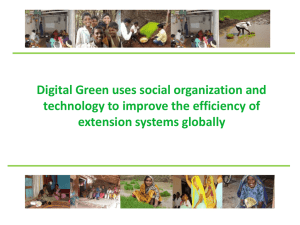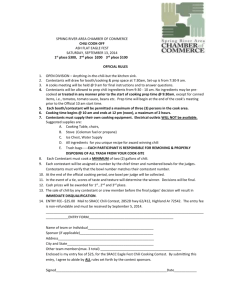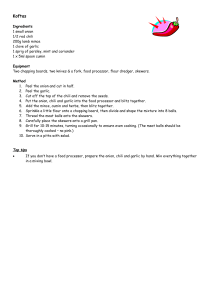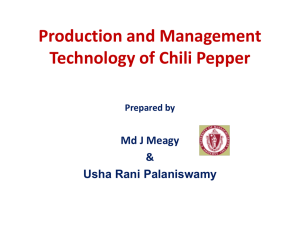Appendix 9: Baseline report - executive summary
advertisement
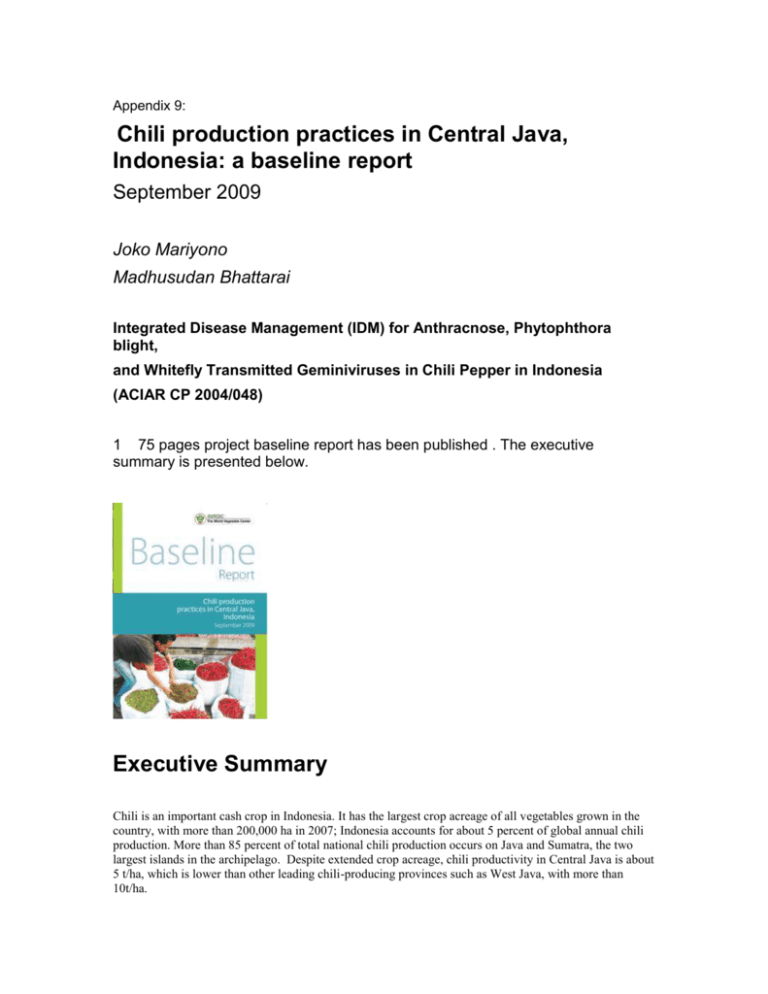
Appendix 9: Chili production practices in Central Java, Indonesia: a baseline report September 2009 Joko Mariyono Madhusudan Bhattarai Integrated Disease Management (IDM) for Anthracnose, Phytophthora blight, and Whitefly Transmitted Geminiviruses in Chili Pepper in Indonesia (ACIAR CP 2004/048) 1 75 pages project baseline report has been published . The executive summary is presented below. Executive Summary Chili is an important cash crop in Indonesia. It has the largest crop acreage of all vegetables grown in the country, with more than 200,000 ha in 2007; Indonesia accounts for about 5 percent of global annual chili production. More than 85 percent of total national chili production occurs on Java and Sumatra, the two largest islands in the archipelago. Despite extended crop acreage, chili productivity in Central Java is about 5 t/ha, which is lower than other leading chili-producing provinces such as West Java, with more than 10t/ha. High yielding chili cultivars resistant to multiple diseases have yet to be successfully developed or adapted, at least not in the case of open-pollinated varieties. Recommended pesticides often are ineffective in controlling many diseases and pests, and traditional cultural practices can spread or favor the growth of some diseases. Thus, the development of satisfactory control measures of some important chili pests and diseases is a high priority for a collaborative project jointly implemented by AVRDC – The World Vegetable Center (AVRDC), Indonesian R&D sector agencies (IVegRI, BPTP/Central Java, Bogor Agricultural University ) and Australian partner agencies (CSIRO and NSWDPI). The project is funded by the Australian Centre for International Agricultural Research (ACIAR). This baseline study was carried out to fill information gaps and analyze various issues regarding chili production at the village and farm household level in Indonesia. The study documents resource allocation decisions of chili farmers in three selected communities of three districts—Magelang, Brebes, and Rembang—that represent distinct agroecosystems of chili cultivation within Central Java province. We have characterized major production practices and socioeconomic features of chili farming, and have comparatively analyzed how these cultivation practices and other key factors of production differ across locations, even within a small geographical region. Farmers in Magelang and Brebes have been growing chili for more than 25 years; farmers in Rembang started cultivating chili about 10-12 years ago. Chili is grown largely by small- and medium-scale farmers, and most chili-growing farmers are younger and more educated than non-chili growing farmers. Most of the farmers surveyed cultivated an area of about 0.6 ha. Of the total farm land, on average about 0.2 ha/farming household was allocated for chili during the dry season, which is half of the land allocated for rice in the same season. Accessing credit was not a problem for the majority of farmers, but only 16 percent borrowed capital to grow chili. Most farmers did not want to cultivate chili using borrowed capital due to the risk of crop failure from pests and diseases or loss of income due to excessive price fluctuation. Although chili can be cultivated in Central Java during all seasons, many farmers grew less chili during the wet season due to the high risk of crop failure by flooding. Canals and tube wells accounted for 68 and 32 percent, respectively, of irrigation sources for chili farming. Crop loss due to pests and diseases has increased recently, and some of these problems are becoming difficult to control. Our study documented the extent of damage and farmers’ concerns toward several major insect pests and diseases of chili. Among the eight major insect pests reported by farmers during the dry season, thrips, mites, and whitefly infestations were most severe. Likewise, among five diseases noted by farmers, the three most important—anthracnose (Colletotrichum capsici), geminiviruses, and Phytophthora—were more serious than the others. During the wet season, risk of anthracnose was very high; in the dry season, risk of yield loss by geminiviruses and Phytophthora was high. Within a province, the severity of insect pest and disease outbreaks varied by location and by season. Most farmers controlled pests and diseases with chemical pesticides. There were more than 80 brand names of pesticides used by farmers in the three sites surveyed in 2007/08. On average farmers applied approximately 12 kg/ha of pesticide on chili in a three- to four-month period), and the frequency of spray was about 23 times over each growing season. Overall, farmers in Brebes, who cultivate the local variety of chili, applied a greater quantity of pesticides and sprayed more than farmers in the other two survey sites. However, some farmers did use alternative methods to control pests and diseases. For the average chili farmer, middlemen and neighboring farmers were the two most important sources of market information. Radio and television were mentioned by one-third of farmers as a source of information for market prices, but not with a high rank value. Farmers sold chili in several ways. Usually, collectors visited the villages to purchase chili to supply larger markets. Farmers preferred to sell chili on the same day of harvest, and they contacted at least one other trader to verify the prevailing price before selling their produce. Several farmers used mobile phones to obtain market price updates. Marketed surplus (proportion of market sale out of the total produce harvested) of chili was very high (nearly 100%) compared to rice (about 65%). This suggests a special role for chili in local economies and rural livelihoods in Indonesia. Farmers grow chili as a cash crop, so profit motivates the decision to grow chili, the level of inputs applied, and the crop intensification pattern followed. Only around 15 percent of farmers in the survey sites attended agricultural training, usually through farmer field schools organized by the local Agricultural Office and the Indonesian Vegetable Research Institution (IVegRI). Compared to Magelang and Brebes, chili farmers in Rembang previously attended fewer training and extension meetings, which is also the reason for their lower level of crop intensification practices and lower crop productivity. In general, chili farmers at all three sites faced similar issues related to production, pests, diseases, irrigation, and marketing. However, each chili production area had also some specific problems, constraints, and risks. Location-specific differences must be taken into account when developing technology recommendation packages and new variety types to ensure wider adoption and impact. +++++++++**********+++++++++



